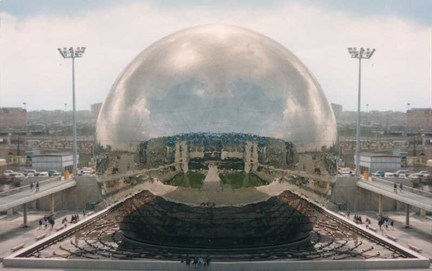Sorry, that’s just not working for me.
Historian’s claim to have found King Arthur’s Round table, and guess what? The Round Table wasn’t really a table at all but an amphitheater. Here is part of the claim:
Camelot historian Chris Gidlow said: “The first accounts of the Round Table show that it was nothing like a dining table but was a venue for upwards of 1,000 people at a time.
As far as I can tell the earliest account of the Round Table is from Wace’s Roman de Brut a translation of which I have in Arthur King of Britain (ed. by Rechard L Brengle). This is what Wace says:
Arthur never heard speak of a knight in praise, but he caused him to be numbered of his household. So that he might he took him to himself, for help in time of need. Because of these noble lords about his hall, of whom each knight pained himself to be the hardiest champion, and none would count him the least praiseworthy, Arthur made the Round Table, so reputed of the Britons. This Round Table was ordained of Arthur that when his fair fellowship sat to meat their chairs should be high alike, their service equal, and none before or after his comrade. Thus no man could boast that he was exalted above his fellow, for all alike were gathered around the board, and none was alien at the breaking of Arthur’s bread.
Apparently, there are earlier accounts that point the ethos of the Round Table, that is, the code of Chivalry, and there are other pieces of furniture and landmarks associated with Arthur in the earlier accounts. Perhaps someone more expert than I on these matters can tell us what Chris Gidlow means when he says that “the first accounts of the Round table” indicate that it was a “venue for upwards of 1,000 people at a time.”
In any case, it is virtually impossible to image how Wace’s account could be referring to an amphitheater.
Gidlow, it seems, may be referring to the earliest account of Arthur given to us by Gildas (c. 540):
Mr Gidlow said: “In the 6th Century, a monk named Gildas, who wrote the earliest account of Arthur’s life, referred to both the City of Legions and to a martyr’s shrine within it. That is the clincher. The discovery of the shrine within the amphitheatre means that Chester was the site of Arthur’s court and his legendary Round Table.”
My anthology only has excerpts of chapters 25 and 26 of Gildas’ De Excido et Conquestu Britanniae, where Ambrosius Aurelianus is explicitly mentioned. I find nothing there about “the City of Legions” or “a martyr’s shrine.” Sounds to me like this is speculation extrapolated from speculation.
A little overconfidence goes a long way.
Filed under: Culture, Heroes, Knights, Media, News Tagged: King Arthur, Round Table

Go to Source


